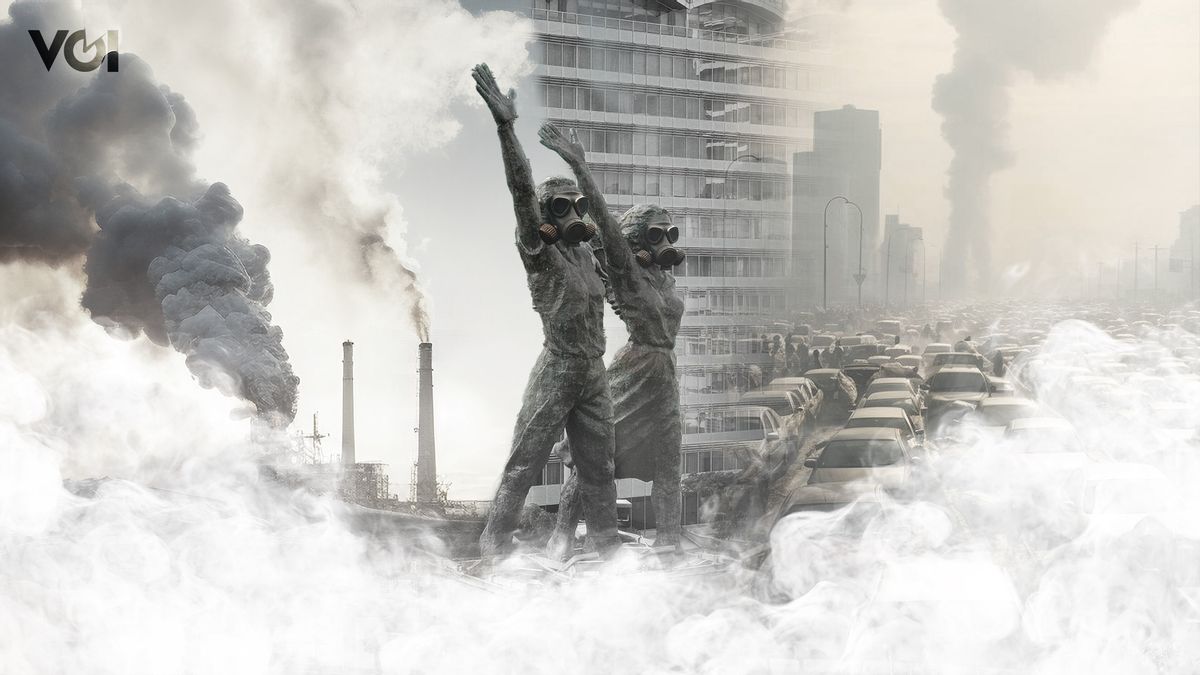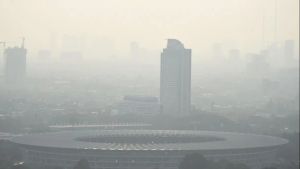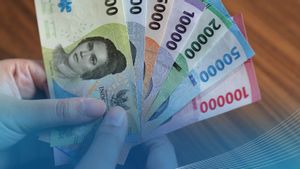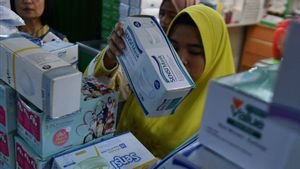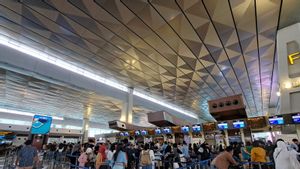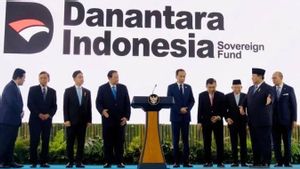JAKARTA - Air pollution in the capital city, Jakarta, until August 31 was ranked fifth on the list of cities most exposed to air pollution worldwide. This data comes from the Air Quality Index (IQAir). The value of Jakarta's air quality index (AQI) reached 167 AQI US, the "Unhealthy" category according to the standard.
The effects of air pollution turn the capital's skies gray rather than blue. As the largest city in Indonesia based on population, Jakarta accommodates more than 10 million people in an area of 661.5 km². Currently, DKI Jakarta also serves as the political and economic center as well as the capital city of Indonesia.
Based on research by the DKI Jakarta Province Environment Agency (DLH), in 2020, the transportation sector is the biggest contributor to air pollution in Jakarta, reaching 67.04 percent. Industry contributes around 26.8 percent, while power plants only 5.7 percent.
Data from Polda Metro Jaya records that there will be 23 million two-wheeled and four-wheeled vehicles in 2023. Every year there is an increase in the number of vehicles by 2-3 percent.
Based on the book entitled Banten in Figures compiled by the Central Bureau of Statistics for Banten Province in 2008, it is clear that the City of Tangerang and the Regency of Tangerang have a fairly large number of companies. It is estimated that the number of companies in the two Tangerang regions accounts for half of the entire industry in Banten Province.
Of course, there are various companies listed and located around Tangerang. Starting from the rubber industry, the food and beverage industry, the shoe industry to the chemical-based industry. The diversity of industries in Tangerang is what gives it the title of the city of a thousand industries in Indonesia.
Apart from Tangerang, Jakarta also has an archipelago bonded zone located in Marunda, North Jakarta and an industrial area in Pulogadung, East Jakarta. Heading west, Jakarta is directly adjacent to Cikarang which is also a national-scale industrial area.
Jakarta is also surrounded by Steam Power Plants (PLTU) from two provinces, Banten and West Java. There are 17 PLTUs in Banten and West Java that rely on coal as an energy source. It is possible that a number of these PLTUs have contributed to air pollution in Jakarta.
A number of PLTUs operating around Jakarta include:
· Banten Suralaya PLTU: 8 units - 4,025 MW
· Cemindo Gemilang PLTU: 1 unit - 60 MW
· Pelabuhan Ratu PLTU: 3 units - 1,050 MW
. Merak PLTU: 2 units - 120 MW
· Cilegon PTIP PLTU: 1 unit - 40 MW
· Java-7 PLTU: 2 units - 1,982 MW
. Banten Labuan PLTU: 2 units - 600 MW
· DSS Serang PLTU: 4 units - 175 MW
. Banten Lontar PLTU: 3 units - 945 MW
· Cikarang Babelan PLTU: 2 units - 280 MW
· FAJAR PLTU: 1 unit - 55 MW
· Pindo-Deli-II PLTU: 1 unit - 50 MW
· Indo Bharat Rayon PLTU: 1 unit - 36.6 MW
· Purwakarta IndoramaPLTU: 2 units - 60 MW
. Banten Serang PLTU: 1 unit - 660 MW
· Bandung Indosyntec PLTU: 1 unit - 30 MW
The existence of industry, the density of vehicles and the 17 PLTUs that surround Jakarta are similar to the City of Beijing. Ironically, Beijing itself is trapped in air pollution due to its topography which is surrounded by mountains.
VOIR éGALEMENT:
According to the National Library of Medicine, Beijing's air quality worsens especially in the spring and summer. High temperatures and humidity, as well as winds carrying pollutants from the industrial sector in the south, are the main causes of the smog. Beijingers experience shorter life spans compared to those living in southern China, by a difference of about five to six years. Air pollution in Beijing has also resulted in decreased birth rates and increased deaths from respiratory diseases. Lung cancer rates have also increased by more than 60% in the last decade, although smoking rates have not increased.
Air quality is measured by the Air Quality Index (AQI) from 0 to 500, with different colored levels indicating the level of air hazard for that day. Scores below 100 are known as "Blue Sky Days", when the haze is not as obvious. The World Health Organization (WHO) states that a score close to 500 contains more than twenty times as much harmful particles in the air.
Air pollution in Jakarta has also increased significantly, causing the city to be covered by thick smog. There is a need for awareness and concerted action by citizens and government officials to deal with this serious threat.
The Head of the DKI Jakarta Walhi Campaign, Muhammad Aminullah, revealed that the government has not dared to impose strict environmental regulations on companies, which in the end will harm the community. The government has recently focused more on the transportation sector as the main source of air pollution, while the focus on companies has not been fully implemented.

Jakartans Face the Threat of Respiratory and Skin Diseases
The issue of severe air pollution in the capital city, Jakarta, has been going on for the last 5 years. However, it wasn't until 2023 that this problem became very serious after President Jokowi experienced a cough which was allegedly caused by air pollution which has become an increasing concern in Jakarta. This air pollution contains PM 2.5 and other harmful substances such as nitrogen dioxide (NO2), carbon monoxide (CO), sulfur dioxide (SO2), and particulate matter 10 (PM10) to PM2.5.
Particulate Matter (PM2.5) are airborne particles with a size less than or equal to 2.5 µm (micrometer). Meanwhile, PM10 is considered a health threat because it can enter the lungs through the respiratory tract and accumulate there. PM2.5 poses a greater health risk because it is smaller than a hair, allowing it to penetrate deep into the lungs.
PM2.5 concentrations were measured using the Beta Attenuation Monitoring method and expressed in units of micrograms per cubic meter (µm/m3). What's interesting is that the BMKG has only started monitoring this particulate matter (PM) in 2020. This means that the government has only been actively monitoring serious problems due to air pollution for the past three years.
Not only has an impact on the respiratory tract, such as acute respiratory infections (ARI), air pollution is also detrimental to skin health. Dr. Irmadita Citrashanty, an expert on skin and venereal diseases from Airlangga University, stated that air pollution contains substances that can damage the skin and accelerate skin aging. "Air pollution contains high levels of Reactive Oxygen Species (ROS), which makes the skin look older than it really is. Signs of aging such as wrinkles and dark spots appear earlier," said Dr. Irmadita Citrashanty as quoted from Unair.com on August 28.
In addition, air pollution can also trigger a recurrence of skin diseases such as eczema, eczema, or atopic dermatitis. Sensitive skin is also at risk of experiencing itching, irritation, and redness. "For skin that is resistant, maybe not much effect, but the risk of skin cancer is still great," he explained. The main factors that cause skin cancer are actually the intensity, frequency, and radiation of sunlight.
The Director General of Disease Prevention and Control (P2P) of the Indonesian Ministry of Health, Maxi Rein Rondonuwu, revealed that ISPA cases in the Greater Jakarta area had increased quite significantly. He stated that this was caused by air pollution in Jakarta. "The Jabodetabek area is experiencing an increase in air pollution problems. Data from disease surveillance shows an increase in ISPA cases reported at puskesmas and hospitals, reaching 200 thousand per month," Maxi said in a press conference from the Indonesian Ministry of Health on August 28.
Jakarta and Beijing: Overcoming Air Pollution Towards Clean Air
A series of actions announced by the DKI Jakarta Government in the third week of August, including the use of electric vehicles for officials at Echelon IV level and above, the work from home (WFH) policy for ASN DKI Jakarta, and plans to modify the weather, have come under scrutiny. However, based on data from the IQAir.com website, air quality in Jakarta reaches 167 and is red, indicating unhealthy conditions.
PM2.5 concentrations in Jakarta are currently 17.4 times the annual WHO air quality guideline value. In fact, the unhealthy weather in Jakarta is expected to last until Friday, August 31.
Professor of Environmental Engineering from the Bandung Institute of Technology (ITB), Puji Lestari, presents several solutions to address the problem of air pollution in the capital city. Its main focus is reducing emissions in the land transportation sector, which is at the root of Jakarta's air pollution problem. "One way is to adopt the EURO4 standard for passenger vehicles such as buses, trucks and motorcycles. Heavy vehicles such as buses and trucks produce more wasteful fuel. Meanwhile, motorbikes also create pollutants such as carbon monoxide (CO)," explained Praise Lestari.
In addition, it is appropriate to follow the example of several cities in the world such as Beijing and Shanghai which have succeeded in changing their air quality from dangerous to healthy. This was disclosed by Ahmad Safrudin, Urban Environment Observer and Executive Director of the Commission for the Elimination of Leaded Gasoline. He stated that the Provincial Government of DKI Jakarta should take an example from air pollution control carried out by Beijing in China. This is because Jakarta and Beijing have similar problems.
"Beijing in 1998 had the highest level of air pollution and then decided to deal with this problem. The high growth of motor vehicles and the use of coal by industry are some of the contributing factors," explained Ahmad Safrudin to VOI.
Based on data from IQAir.com, Beijing is currently ranked 59th with a US AQI of 45 and PM2.5 concentrations in Beijing reach 1.4 times the annual WHO air quality guideline value. Shanghai, on the other hand, is ranked 71st with a US AQI of 33 and PM2.5 concentrations in Shanghai are 2 times the WHO annual air quality guideline value.
In a matter of days, DKI Jakarta will host the ASEAN Summit. The question is, can DKI Jakarta accelerate and improve efforts to tackle air pollution, so that the meeting of ASEAN countries runs smoothly and is successful?
This ASEAN Summit moment also has the potential to be an impetus for the birth of many new policies in dealing with air pollution in Jakarta. Although emergency measures may need to be taken depending on the level of pollution, the most important factor in controlling air pollution is the strict adoption of new laws and the reform of existing laws.
The English, Chinese, Japanese, Arabic, and French versions are automatically generated by the AI. So there may still be inaccuracies in translating, please always see Indonesian as our main language. (system supported by DigitalSiber.id)
